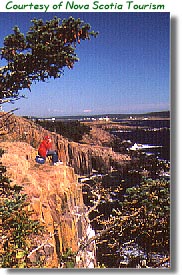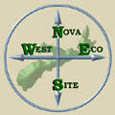Brier Island (Westport)
This area is heavily documented as a migrant birding
area. It is the last "bus stop" in Nova Scotia before land
and sea birds migrate across an expanse of  ocean
to the mainland. The best time to see a variety of bird species is
during the southern migration season on the southern tip of this island.
To access the Brier island from Digby, coming from highway 101, turn
right (North) at the Hwy Exit 26, turn left (North) at the only set
of intersection stop lights in town, toward the West Ferry. At the
four-way stop, turn left (West) toward the Tiverton island on highway
217. The East Ferry runs from the Petite Passage to the Tiverton island.
The ferry costs $2.00 (Return) and transports vehicles every half-hour
for 24 hours. Take the East Ferry across the Petite Passage, to the
Tiverton island, then proceed to Freeport to get on the Westport ferry,
that proceeds across the Grand Passage to Brier Island. Once this
half-hourly ferry arrives at Westport, Brier Island, turn right (North)
to Northern Point. For accommodations local to this area click Accommodations,
Brier Island.
ocean
to the mainland. The best time to see a variety of bird species is
during the southern migration season on the southern tip of this island.
To access the Brier island from Digby, coming from highway 101, turn
right (North) at the Hwy Exit 26, turn left (North) at the only set
of intersection stop lights in town, toward the West Ferry. At the
four-way stop, turn left (West) toward the Tiverton island on highway
217. The East Ferry runs from the Petite Passage to the Tiverton island.
The ferry costs $2.00 (Return) and transports vehicles every half-hour
for 24 hours. Take the East Ferry across the Petite Passage, to the
Tiverton island, then proceed to Freeport to get on the Westport ferry,
that proceeds across the Grand Passage to Brier Island. Once this
half-hourly ferry arrives at Westport, Brier Island, turn right (North)
to Northern Point. For accommodations local to this area click Accommodations,
Brier Island.
Individuals such as Lee Calkin, author of the brochure The Sandpipers
of Fundy; Peter Hicklin, a wildlife biologist; and Harry Thurston, naturalist and
author of the book The Nature of Shorebirds advise on-lookers to keep their
distance away from these migrating birds and remain on look-off sites or platforms
specifically made to facilitate sight-seers. It is imperative that these birds not be disturbed because they need to eat enough food to fuel themselves for their long
journey. If they fail to obtain enough sustenance, they will experience what
Thurston calls "Migratory Failure". In an interview with Rebecca
Fleming, Thurston reports that "Some of these birds just literally end up
dropping out of the sky" if they fail to obtain sufficient sustenance.
Annapolis Causeway (near Tidal
Power Plant)
Some of the more uncommon birds spotted on the Annapolis
Causeway, as reported during the wintertime, include Common Goldeneyes,
and Barrow's Goldeneyes. Other species can be viewed here in the Annapolis
Royal area such as the marshes and dykelands, adjacent to and accessed
from the Historical
Gardens or along the Victoria Beach Road,
where an Annual Christmas Bird Count was held on January 3, 1998,
by the Nova Scotia Birding Society. According to that Bird Count such
birds as Oldsquaws, American Black Ducks, European Starlings, Herring
Gulls, and Bohemian Waxwings were found in
abundance in Annapolis. Click accommodations,
Annapolis Basin for local living arrangements
located on Highway 1, as well as on St George, Ritchie, and Victoria
Streets.
Kejimkujik National Park (suggested Trails)
Ospreys,
Hooded Mergansers and Wood Ducks build their nests here in the Kejimkujik
Park. Although, waterbirds may not be as common. Shorebirds migrate
in the Seaside Adjunct area from August through to October. Waterbirds,
Crows and perching birds return in abundance by early spring. Summer
is the time for birds such as Grouse, ducks and Mergansers to be common
to the area. Most migrations occur in early Fall but straggling perching
birds that migrate may remain until late October. Remaining or stay-resident
birds include species such as Chickadees, Kinglets, Nuthatches and
Woodpeckers. Residential waterbirds, which are few in number, may
be found in the Mersey River or Grafton Brook.
Hardwood areas where birds such as Woodpeckers, Warblers and Thrushes may
be found include trails such as Grafton Lake, Beech Cove,
Peter Point, and Roger's Brook. Softwood areas
include birds from northern Canada, Chickadees, Red-breasted Nuthatches, Grey jays, Spruce
Grouses and Black-backed Woodpeckers located near trails such as Farmlands,
Flowing Waters and Big Dam Lake. To immediately
find an edge-habitat for birds that inhabit mixed stands, the Hemlocks and
Hardwoods Trail is a good choice, or any hardwood trail that eventually converges
with a softwood trail, or vice versa. Waterfowl can be found on Port Joli
Head, Grafton Lake Trail. Shore or Sea birds can be found
on the Harbour Rocks or Black Point.




